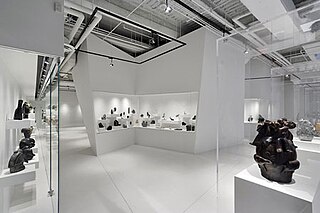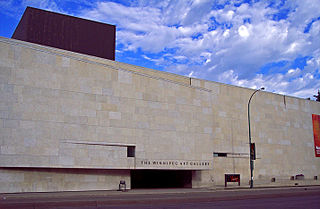 W
WInuit art, also known as Eskimo art, refers to artwork produced by the Inuit, that is, the people of the Arctic previously known as Eskimos, a term that is now often considered offensive outside Alaska. Historically, their preferred medium was walrus ivory, but since the establishment of southern markets for Inuit art in 1945, prints and figurative works carved in relatively soft stone such as soapstone, serpentinite, or argillite have also become popular.
 W
WThe Dennos Museum Center is a fine art museum and cultural center located in Traverse City, Michigan on the campus of Northwestern Michigan College (NMC). Most notable for its permanent collection of Inuit art, the Dennos Museum opened in 1991 and features rotating exhibitions of Modern and Contemporary art.
 W
WMasks among Eskimo peoples served a variety of functions. Masks were made out of driftwood, animal skins, bones and feathers. They were often painted using bright colors. There are archeological miniature maskettes made of walrus ivory, dating from early Paleo-Eskimo and from early Dorset culture period.
 W
WThe Museum of Inuit Art (2007-2016), also known as MIA, was a museum in Toronto, Ontario, Canada located within the Queen's Quay Terminal at the Harbourfront Centre. It was devoted exclusively to Inuit art and culture.
 W
WIn Greenlandic Inuit religion, a tupilaq was an avenging monster fabricated by a practitioner of witchcraft or shamanism by using various objects such as animal parts and even parts taken from the corpses of children. The creature was given life by ritualistic chants. It was then placed into the sea to seek and destroy a specific enemy.
 W
WUqqurmiut Centre for Arts & Crafts is an arts centre that was established by the Uqqurmiut Inuit Artists Association in 1990, in Pangnirtung, in the Qikiqtaaluk Region of Nunavut, Canada. The Centre includes a Tapestry Studio, a Craft Gallery, and Print Shop. In spite of its remote location and small population, numerous Inuit from Pangnirtung have successfully marketed their prints, carvings, sculptures, and textile arts, such as woven wall hangings, to southern collectors. Starting in the 1970s, limited edition prints from the original Print Shop were published annually as the Pangnirtung Prints Collection through the then-Eskimo Co-operative. In 1970 a weaving studio was established and over time the tapestries attracted an international market.
 W
WThe Winnipeg Art Gallery (WAG) is an art museum in Winnipeg, Manitoba, Canada. Its permanent collection includes over 24,000 works from Canadian, and indigenous Canadians, and international artists. The museum also holds the world's largest collection of Inuit art. In addition to exhibits for its collection, the museum has organized and hosted a number of travelling arts exhibitions. Its building complex consists of a main building that includes 11,000 square metres (120,000 sq ft) of indoor space and the adjacent 3,700-square-metre (40,000 sq ft) Qaumajuk building.